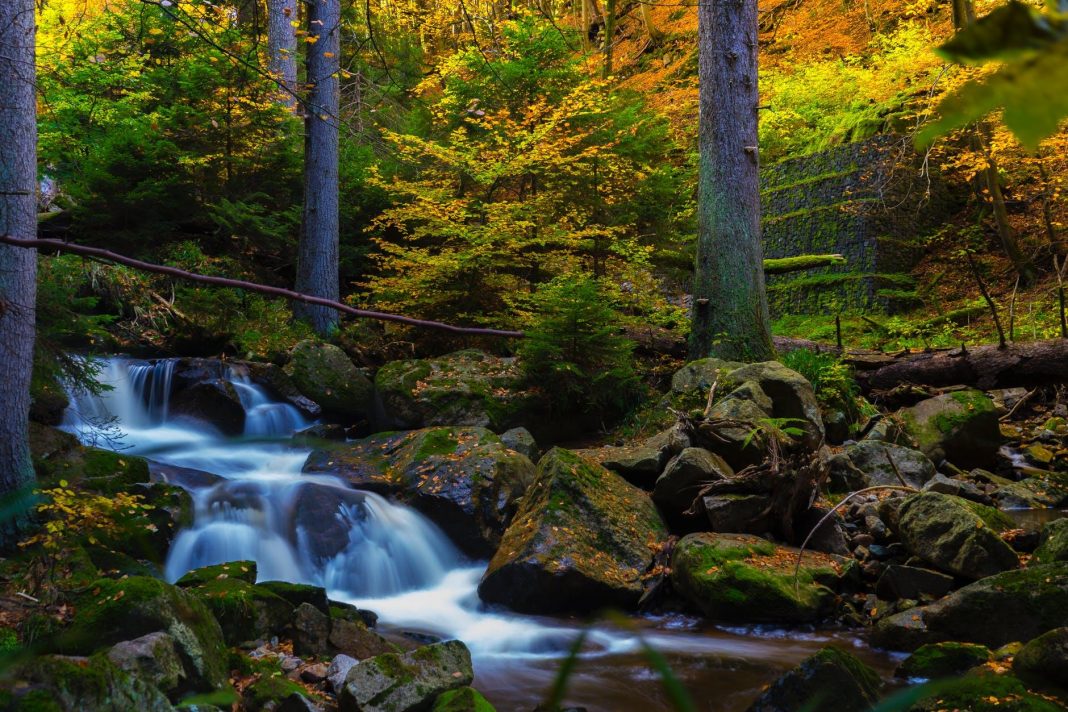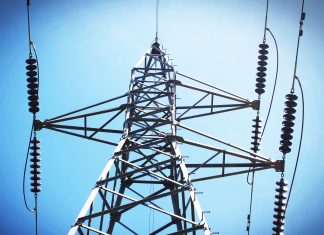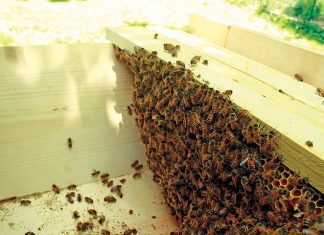| Issue #28 • July/August, 1994 |
Just as the words “backwoods home” conjure up images of farmhouses, livestock, woodstoves, tractors, and gardens, the words “independent energy” bring to mind a whole new set of images, like solar panels, windmills, hydro electric generators, inverters, and batteries.
According to Webster’s Dictionary, the word “independent” means to be self governing, not easily influenced, and showing self reliance, while “energy” is described as the capacity to perform work. These qualities of self reliance and work go hand in hand with a backwoods home lifestyle and the use of independent energy.
 |
Anyone who is seriously considering a move to the country should become informed about energy and its proper use and production, the same as one would learn about raising livestock, growing a crop, or making a living.
When great grandpa or your great-uncle Joe settled down on his 160-acre government-granted homestead, independent energy was perhaps an ox, a mule, seven healthy children, or better yet a prairie windmill. Today we have much better choices of equipment, but the idea of producing your own energy from your own source and having it do useful work is still the same.
For more than 20 years I have been involved in the use of independent or “alternative” energy and the design or modification of related equipment, as well as sales and service of off-the-shelf equipment. Years of fielding customer questions on energy production and consumption have led me to the conclusion that for most people energy is not a subject they feel comfortable dealing with.
I suppose a lot of this comes from the fact that the average person has never had to deal directly with energy beyond paying a utility bill. I have also found that many of these same people have a somewhat unrealistic view of what an independent energy system can and cannot do, so they have a hard time selecting the proper equipment to suit a particular task. For many there is a romantic appeal to the idea of being completely free of utilities; this can get them into trouble without proper guidance.
It would be equally unrealistic for me to attempt to cover such a detailed subject as independent energy in a simple article, so this article is hopefully going to answer some of the most often asked questions and try to give some rule-of-thumb guidelines that will be helpful.
If you truly wish your source of energy to be independent, there are only a few choices: solar in the form of solar electric panels, hot water panels, and passive heating; wind generators for electric production and windmills for water pumping; and hydro electric generators.
I can hear all those living on gas or diesel generators letting out a moan, but in reality these generators should be used strictly as backups to an independent system or for occasional heavy use. If you have a good solar, wind, or hydro source or a combination of one or all, a fossil fuel generator as sole source just doesn’t pencil out economically, and it certainly can’t be seen as independent because of the fuel source.
There are areas of the country where these generators will be the only practical source though, and one simple rule should be followed in their use: It rarely makes economic sense to use the generator as sole source without the use of an inverter/charger and storage batteries. Even the smallest generator will spend most of its time running loads far below capacity with overall efficiencies as low as 5 or 10 percent.
An inverter running from batteries charged by the generator will not only increase the overall efficiency to its maximum and save a lot of money, but the reduction in maintenance and noise are well worth the extra effort.
Pump water sensibly
As most people I’m sure are aware, the most important thing in having a successful backwoods home experience is a source of good clean water.
For all of those readers who are blessed with a shallow spring, streams, or lots of gravity-fed water, skip to the next section, but for anyone who has to pump water from a well of any real depth (100 to 700-plus feet) read on.
The one item that causes most people a lot of headaches when living on solar, wind, or hydro power (unless the system is very large and supplies are abundant) is water well pumping.
Most off-the-shelf water well pumping equipment was designed without much consideration for power consumption and efficiency.
When using any independent energy source, the key to success is to limit the peak demand the system must supply, even for short periods, to a minimum. This rule dictates that pumping at slow (fewer gallons per minute) rates for long periods (hours) makes far more sense than pumping at a high volume for a few minutes and shutting off. (Note: This rule, of course, does not apply to those who pump water directly using a generator, since it is always best to load a generator to near full capacity in order to maximize efficiency.)
This leads to the second rule, that a successful system should include a cistern or large (1000-plus gallons) storage tank. This not only allows the use of a smaller, less power-demanding pump, but it
also gives you a reserve supply in case the pump fails.
You can easily open a tank and dip out some water temporarily, but water that’s still several hundred feet down a small hole can be a problem.
You will need a second small pump to draw water from the cistern and pressurize it, but this redundancy is countered by the fact that a small shallow-water pump can deliver far more water in gallons per minute on less power than even most large deep-well pumps.
For depths of 50 to 300 feet, a good low voltage DC submersible pump can supply all the water needed by the average household, even when watering gardens if first pumped to a cistern.
To give an example of how much advantage a storage pumped system can be, let me tell you about a solar electric system I just installed. The customer has a 150-foot deep well that would easily be pumped by a small DC submersible. Had she installed a cistern her pump power demands would have been around 100 watts. This pump could have easily run all day and delivered over 800 gallons.
Since she had some unrevealed reason for her objection to a cistern, a ½ horsepower 110-volt alternating current (AC) pump was installed. This pump draws over 1500 watts and requires a large inverter. At this rate she is limited to around 100 gallons per day to avoid depleting her system. This is a 15-fold increase in power with an 8-fold decrease in water delivery.
Even the best AC submersible pumps are less than 25% efficient when run through an inverter and only slightly more efficient when on the grid or generator. They are generally a poor choice to be included in an independent energy system. A second very good choice for deep well pumping on an independent power source is a jack pump. See Backwoods Home, Issue #25, “The solar powered silent partner,” for more details.
Here’s a word of caution to all those who may be drilling a well and selecting a pump system. Beware of pump dealers and installers who insist on sizing your pump using an industry standard formula called the seven- minute demand rule.
This rule is supposed to determine how many gallons per minute your pump should deliver based on a total of some hypothetical delivery rates for various household fixtures.
I have found these rates to be very excessive and size my pump systems to less than half of these published figures. I have yet to hear a customer complaint due to a lack of water.
I think this rule was set up for the convenience of the installer, not the economy of the customer. Use a stop watch and a gallon container to get a feel for your own household water needs before making a decision.
Conservation is key
I can’t stress enough the importance of conservation in the successful use of any independent energy system.
Although conservation by itself is not a true energy source, in a round about way it can be seen as one. Every watt you don’t use is one you don’t need to produce.
It takes dollars in the form of equipment to generate any form of energy.
This does not imply that you need to live a Spartan, harsh life and deny yourself certain advantages to use an independent energy source, but it does mean changing some of the bad habits acquired when living on the grid.
Unfortunately, efficiency is an after- thought in the design of most American appliances and household devices, which makes their use in an independent energy system a little more difficult, but not impossible. Most of my customers are amazed at how little energy their systems produce when first living on it, but how in just a few months they find it producing all they need.
Reminds me of Mark Twain’s story of how when he was 13 he felt his father was as dumb as could be, but by the time Mark Twain had reached adulthood, he was amazed by how much his father had learned.
A good rule of thumb is that once you eliminate the use of electricity for space heating, water heating, and cooking (electric stoves), most any house can be operated successfully from a solar, wind, or hydro system.
A very frequently asked question from potential customers is: “What size system do I need?,” or “How much does it cost to supply enough power for an average house?” My reply is always the same: “Houses don’t use energy; people do.”
This gets to the heart of the fact that there is no “average house” and that each household is unique.
Two different households may have the same number and ages of occupants, the same appliances, and the houses may be of the same square footage, but one may heat with wood and have a mountain spring as a water source, while the other may have a forced air gas furnace and a very deep well. These differences will mean that the house with the forced air gas heat and deep well pump will have a far greater power demand for heating and water, but may have a smaller demand overall if the occupants of the other house are constantly wasting energy.
I don’t mean to make the installation of an independent energy system seem ominous and overly complicated, but I use these examples to illustrate the fact that proper planning and the help of a qualified designer and installer can mean the difference between success and failure. At best it will mean a system that works poorly versus one that gives years of satisfying and independent service.
The term “independent energy system” usually implies the use of electrical energy derived from an independent source, but a really well thought out and logically planned system should be more than that. A household energy system will involve using more than one source of energy for more than one end use, and if energy efficiency and conservation techniques are not incorporated throughout the system, the advantages derived from an independent source may be reduced.
Heat your house sensibly
As an example of this, let’s look at space heating. Unless your backwoods home is located in a very mild climate, just about everyone in North America needs to heat his or her house at some time.
A very common heat source for many is the woodstove. In most cases this is sufficient, but I see a lot of people who see heating with wood as somewhat of a free lunch.
Wood may be gathered for little or no money, but energy in the form of human effort must be expended to cut and gather it, as well as fuel used to run the chain saw and haul it. When you look at the time spent in gathering, cutting, hauling, and stacking woodand if you value your time to do other things around your homesteadit makes sense to be sure your home is as energy efficient as possible.
This is especially true if you use blowers to move the heat in the home. A large blower fan (or one that runs a lot) can add up to a significant amount of electrical energy that your independent system must provide.
A very wise choice you can make when selecting a heating system regardless of the fuel source is to use hydronic or water-based heating, either a baseboard or a radiant in-floor system. The amount of electrical energy needed to move heated water throughout the house is a fraction of that needed to run a blower.
You will also eliminate the dry, dusty air and drafty cold spots associated with other systems.
In most cases the size of your solar, wind, or hydro system can be reduced by as much as 50%. Remember that you will be placing maximum demand on the system at a time of year when the energy source is at a low point when using a solar energy system. While we are on the subject of space heating, I must mention the use of a passive solar greenhouse as a heat source. There are few areas of the country where the greenhouse can’t supply some portion of your space heating needs and give the added benefit of fresh vegetables almost year round or at least be a good place to start plants for the spring planting.
Luxuries and such
I can think of only a few people I have known who made the move to the backwoods and didn’t take along most of their habits and desires acquired while living in the city or suburbs. Most of this baggage is very quickly shed when they find them impractical and for the most part unnecessary.
Things like Cadillacs and Volvos are soon traded for Chevy pickups or jeeps when it’s discovered that hay bales and goats, barbed wire and fence posts, and muddy roads and potholes are real killers of fancy cars.
A few desires most country transplants still retain and really don’t have to give up are “luxuries” like hot running water, refrigerators and freezers, entertainment centers, and computers.
A word of caution to anyone who is looking to install a solar, wind, or hydro system and wants to be sure that appliances you purchase for your move to the country are compatible. Don’t buy any gas range that doesn’t have a true electronic ignition system. Ask the salesman if it has what is called a glow bar igniter. If it does, keep looking. These igniters are real energy hogs and will be a real nuisance.
I can’t think of any good reason why a solar hot water system shouldn’t be included in a backwoods home, even if money is short. A few rolls of black plastic pipe laid out on the roof makes a handy heater. Reliable and super efficient refrigerators and freezers are available that run on most any independent energy system. The cost of these appliances is higher than average, but even a propane gas refrigerator is expensive to purchase and can burn as much as two gallons of propane per week. What happens when propane isn’t available or you lack the money to purchase it?
Even the smallest independent energy system can power a stereo or TV.
Yearning for independence
All of the advice I have given so far has been directed toward helping make the use of independent energy a pleasant and, most importantly, a liberating and self reliant experience. This experience I feel is unique and can lead a person to look beyond energy needs to even greater self reliance.
It amazes me how many people move to the country to “get away from it all,” but still have the umbilical cord of city or suburban life attached.
Recently I made a call on a cattle rancher several miles east of my place to see about installing some solar water pumping equipment and to talk with him about weaning his ranch from the grid.
It took half an hour of driving through endless stretches of sage brush and juniper trees to get to his ranch house. I could see the house from at least seven miles away, and what really struck me was the thin single electric line running to the ranch house on pole after pole. In reality this line probably ended at the turbines on the Columbia River about 150 miles to the north.
This rancher is fiercely independent and feels very little connection to the suburbs of distant cities, but because everything on his ranch depends on that one thin umbilical cord and the willingness of some corporation to supply the power, his real self reliance and independence is diminished.
He has decided that the technology of independent energy and the need to preserve and enhance his own independence have matured at about the same time. He will soon be free of the grid.
Perhaps it’s now your turn.
(Larry Elliott is the owner of Solar Tech, 27250 Willard Rd., Bend, Oregon, where he designs and installs independent energy sytems. Phone: 503-388-2053.)













